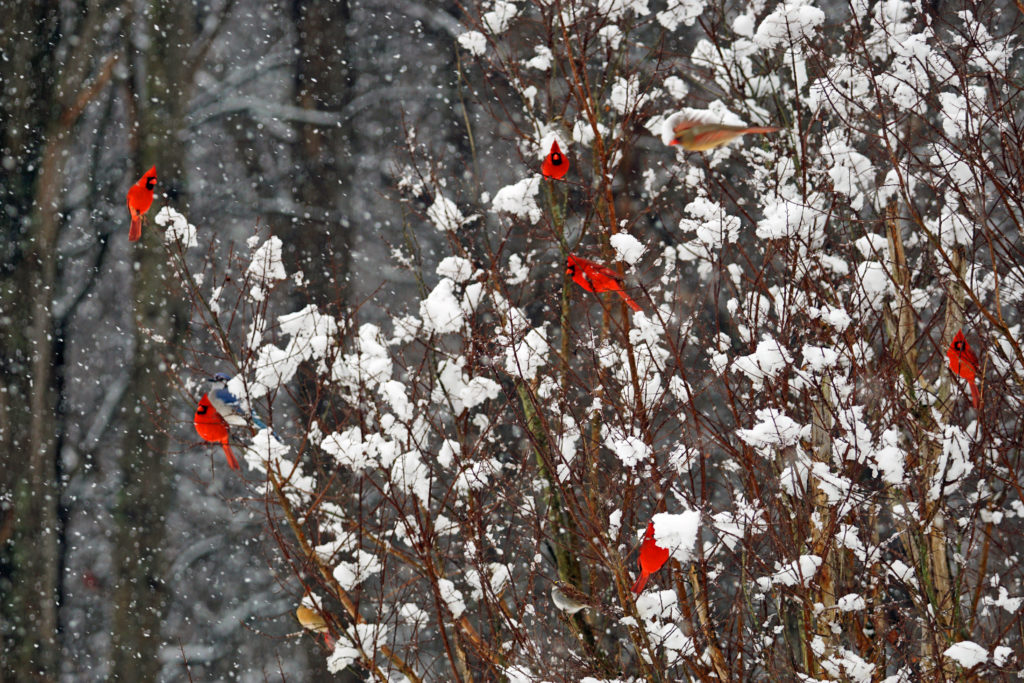
Cardinals adorn a snow-covered shrub with a white-throated sparrow and blue jay tucked in the background. Photo by David P. O’Callaghan
Birds depend on native shrubs and trees for their survival. They offer birds food, cover from the weather, a place to hide from predators, and a spot to build nests and raise their young.
Shrubs and trees provide birds with the essential elements of home.
In winter, evergreen trees such as hemlocks, hollies, white needled pines, evergreen magnolias, and eastern red cedars offer birds with extra protection from the elements and predators like hawks. When planning a garden, the birds will appreciate the evergreen trees you plant in addition to deciduous ones.
Looking for a reason why native shrubs and trees are better than non-native or exotic ones? The 50-year-old crepe myrtle shown in the photo. It only serves as a perch for the birds looking at the nearby feeders. Native to China and Korea, crepe myrtles offer no benefits to any wildlife. Nor do they offer birds with a place to build nests, food, or cover from bad weather. (In the 30 years that I have lived with that crepe myrtle, no bird has ever built a nest in it.)
Supporting Birds in Winter
Creating a habitat that supports birds means providing food, water, and shelter. Those elements can all be built into your yard and garden without adding feeders.
By growing a mix of native plants that attract pollinators and other insects, you provide food for birds. Grow plants in large groups, not individually. This allows pollinators to easily travel from plant to plant without wasting energy traveling all around your garden looking for pollen or nectar.
Many trees also support native insects. Others grow berries or both. Trees such as the white oak, hickory, holly, and dogwood are among those that are invaluable additions to wildlife in any garden or yard.
Non-native shrubs can be harmful to birds. Some non-native shrubs are not strong enough to hold up a nest so when birds create a nest, it may collapse.
If you allow leaves to remain under your garden beds, shrubs, and trees during the winter, you will provide ground-feeding birds with food. Migrating robins delighted foraging under my magnolia tree this winter in leaves left from the fall. Sparrows, another foraging bird, appreciated them too.
Be sure to have water available for the birds whether a birdbath, pond, or stream.
Tips for Feeding the Crew
In addition to creating the proper habitat for birds, you can also put out feeders. They are especially valuable in winter. I started with one and now I have more than a dozen. Family members give me one every Christmas.
Black oil sunflower, enjoyed by most birds, is relatively inexpensive. Try to avoid placing it above a garden. The shells will make the soil too acidic for most plants.
Chipped sunflower: I use this in the feeders over my garden. It is about three times as expensive as black oil, but the birds adore it. It even attracts blue birds in winter, which do not normally come out of the woods until spring.
Suet: woodpeckers love this greasy treat. We get red-bellied, hairy, downy, and occasionally a piliated. It also attracts grackles and black birds.
Shelled peanuts: a favorite of woodpeckers, blue jays, nut hatches, and others.
Peanuts in the shell: blue jays are crazy about them; red bellied woodpeckers eat them occasionally too. The only problem is that you may attract too many blue jays.
Thistle seed: this is a great seed for finches, dark-eyed juncos and other sparrows, as well as other small birds.
Safflower: Cardinals and some small birds like safflower.
An advantage of thistle and safflower is that racoons and squirrels do not like them. All my feeders with other seeds, nuts, or suet are equipped with baffles to keep the raccoons away. Raccoons can be a serious issue if you do not bring the feeders in at night, but that is another story.
For more information about feeding birds, see the New York Audubon’s article: https://ny.audubon.org/birds-0/bird-habitat-necessities#:~:text=Birds%20need%20places%20where%20they,places%20of%20retreat%20and%20safety.
